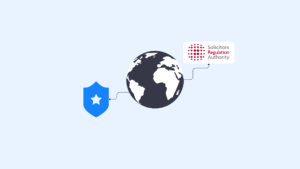AI technology has evolved rapidly from a novelty to a threat to socioeconomic, political, and democratic processes worldwide via deepfake fraud. Deepfake detection software, including Identity Verification (IDV) solutions such as document verification and biometric verification, must be adopted swiftly to ensure economies, governments, and our everyday lives can continue uninterrupted.
The impact of deepfakes on elections, public trust, and business authenticity is a growing concern. As we approach critical election cycles in several democracies, understanding the dangers posed by this technology is more important than ever. This guide examines in more detail how these threats are coming to fruition and the best practices for stopping them from plaguing the digital world.
What is a Deepfake?
Deepfakes get their name from an Artificial Intelligence (AI) methodology, deep learning. A Deep learning algorithm is capable of teaching itself how to solve extremely complex problems by analyzing vast data sets. These algorithms can swap faces into images, videos, sounds, and any other form of digital content to create hyper-realistic but fake content.
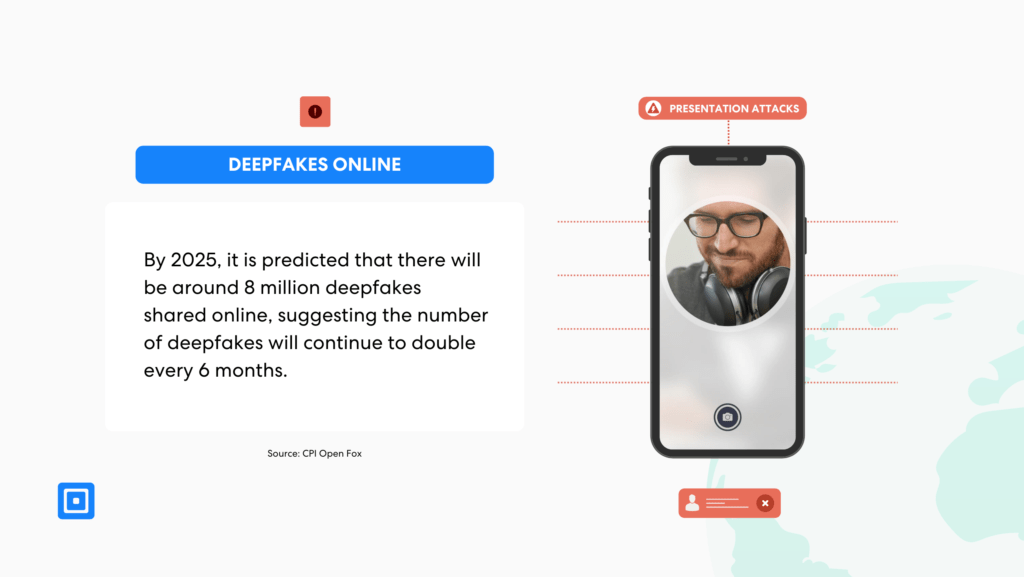
The world is quickly heading into a deepfake crisis, with major fears over how this AI technology will impact and is already impacting the global socioeconomic and political environment. Most recently, fears of election integrity results have come under scrutiny.
What is Deepfake Detection?
Deepfake detection is the process used to identify images, sounds, or videos that are artificially created to look hyper-realistic. Generally, generative AI is used in the document verification and biometric verification processes to detect patterns in deepfake content that would not exist in ‘real content’.
AI-powered IDV solutions are quickly becoming the only way to reliably counter deepfake technology and mitigate this type of identity fraud. Comparably to a human, these technologies can identify spoofed content far more effectively, being able to process far more data over a given period of time, far more accurately, and far more cost-effectively.
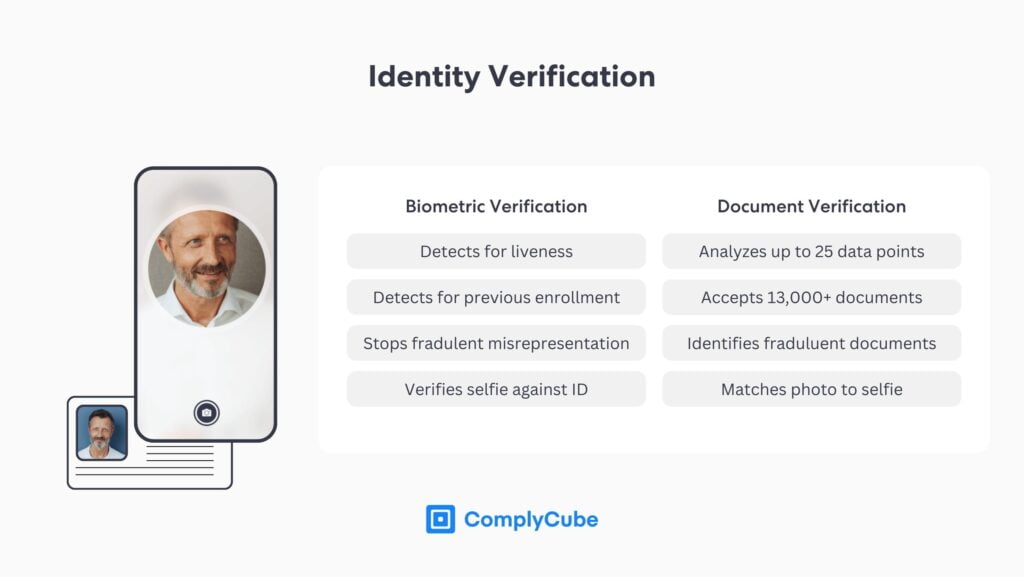
In September 2023, 3 key law enforcement agencies, the National Security Agency (NSA), Federal Bureau of Investigation (FBI), and the Cybersecurity and Infrastructure Security Agency (CISA), released a paper declaring that deepfake threats had increased exponentially and automated nad preventative technologies were essential.
Threats from synthetic media, such as deepfakes, have exponentially increased.
The rising threat of deepfakes around the world and between industries demands a greater need for robust identity verification solutions. Such solutions require similar Generative Artificial Intelligence (Gen AI) to power preventative measures that can counter fraudulent threats.
Document Verification
Document verification is one of the two key steps in Anti-Money Laundering (AML), Know Your Customer (KYC), and IDV processes. This process uses an AI-powered verification engine to read KYC documents, such as a driver’s license, in under 15 seconds.
Simultaneously verifying document authenticity and extracting the available data, document verification provides a strong level of identity assurance. It also acts as a robust preliminary deepfake detector system, being able to identify artificially created images of ID cards. For more information on Gen AI and deepfake detection methods, read Generative AI Fraud and Identity Verification.
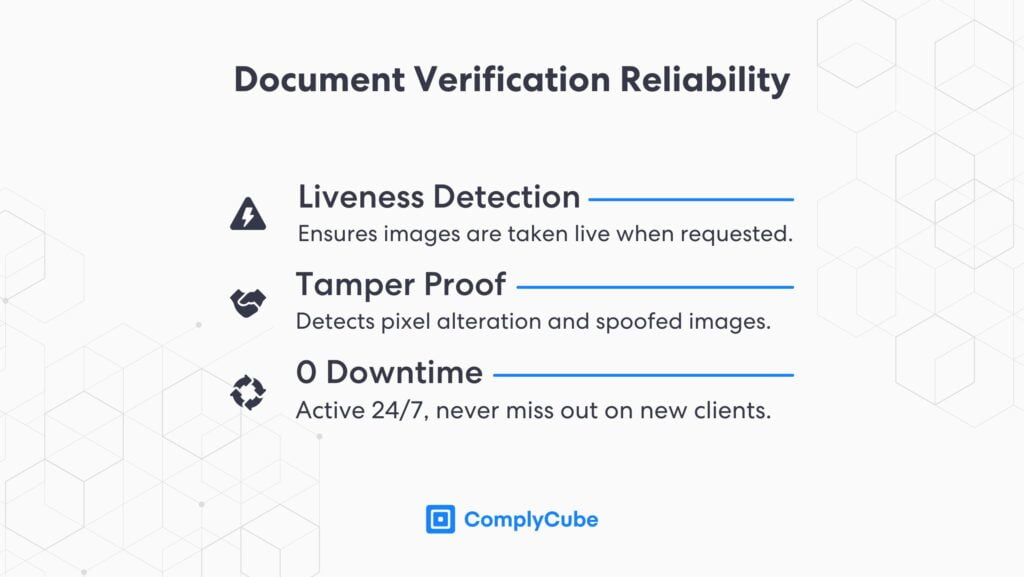
Biometric Verification
Biometric verification uses powerful biometric identification and facial recognition technologies to scan, verify, and authenticate user biometrics. Analyzing biometric information, such as facial features, micro-expressions, skin tones, and texture (sometimes using alternative data such as iris scans), this process acts as a liveness detection tool and prevents presentation attacks, such as deepfakes.
Biometric authentication and verification are the most assured methods of verifying a person’s identity and are imperative in the detection of deepfakes. Biometric data is the most difficult to forge, even with AI; however, this does not mean that deepfakes are easy to detect.
Automated IDV solutions are a critical component in modern identity verification, client acquisition, and authentication processes due to the sheer volume of checks that must be completed accurately and at scale. For more information, read The Advantages of Biometric Verification.
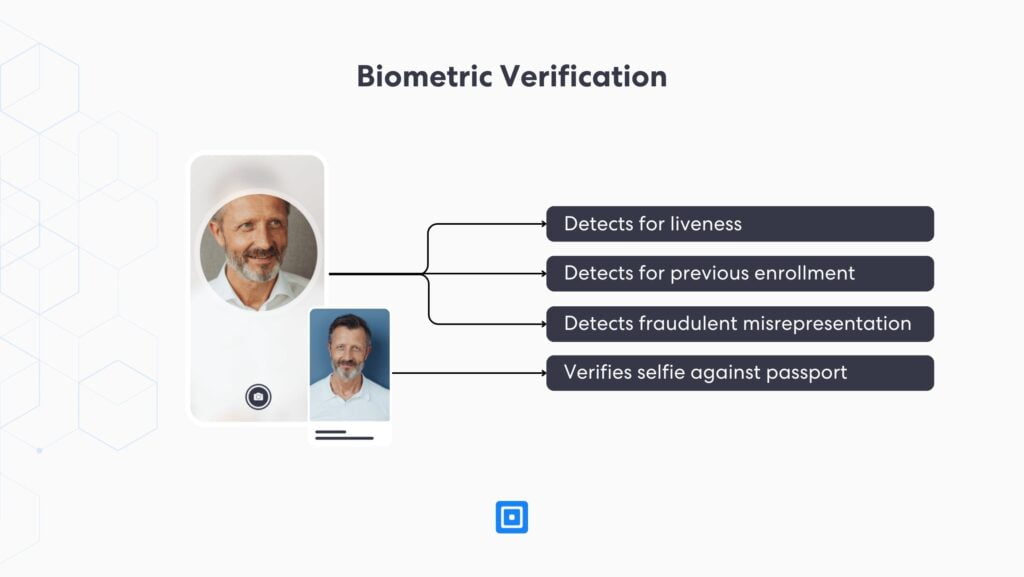
Deepfakes and Election Integrity
Deepfakes have the potential to undermine elections by spreading false information and manipulating public opinion. In the UK, a recent study from The Alan Turing Institute found that nearly nine out of ten people are worried about deepfakes influencing election outcomes (The Alan Turing Institute).
9 in 10 concerned about deepfakes affecting election results.
This concern is not unfounded. High-profile instances of deepfakes targeting political figures, such as fabricated audio and video clips of prominent leaders, have already surfaced, with potential to sow discord and confusion among voters.
For example, in the run-up to the UK General Election in 2024, deepfakes mimicking the voices of then Prime Minister Rishi Sunak, Labour leader Keir Starmer, and London Mayor Sadiq Khan were distributed around social media, reaching hundreds of thousands of viewers and creating misconceptions.
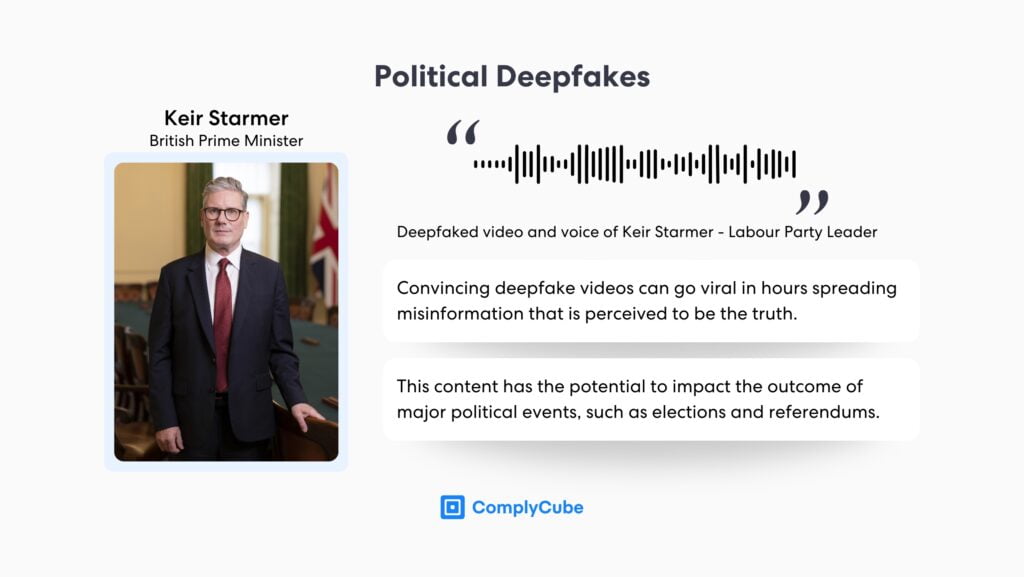
These manipulations ranged from fake corruption scandals to misleading statements about political positions and intentions. Such content can be incredibly damaging, especially when voters cannot distinguish between real and fake.
Deepfake Detection and Response
Detecting deepfakes is increasingly difficult, even for technology giants like Meta, Google, and Microsoft, which have pledged to tackle deceptive AI in elections. The main issue lies in the sophistication of AI tools that can create content indistinguishable from reality.
For instance, Meta’s President of Global Affairs, Nick Clegg, has noted the challenges in identifying AI-generated content, emphasizing that malicious actors can strip away invisible markers that usually indicate manipulation.
The threat of deepfakes is global and appears to follow international events. In America, deepfakes mimicking President Joe Biden’s voice were used in a robocall to share false information about the election. This incident highlights the potential of deepfakes to suppress voter turnout by spreading misleading information.
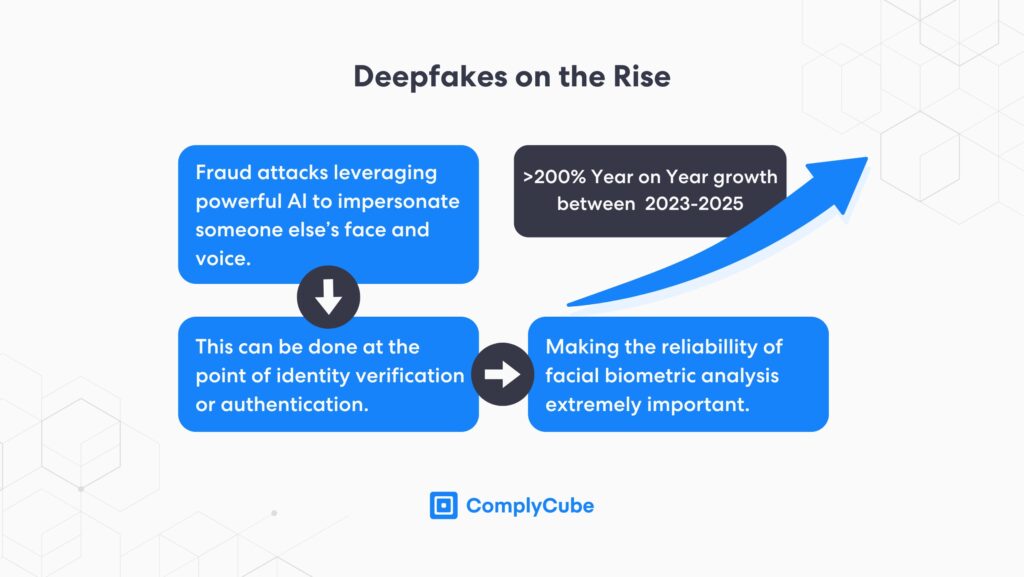
Moreover, the problem extends beyond just identifying deepfakes. The rapid spread of fraudulent content means that once a deepfake goes viral, it’s likely that the damage has been done before the image or video is debunked.
This necessitates action on fraudulent content before it can be uploaded. Social media platforms such as Twitter (now X), Facebook, Instagram, and many others, must employ robust AI-powered defenses to recognize fraudulent media before they can be posted. Such an action could be performed via powerful liveness detection SDKs and APIs. For more information, read Integrating with a Liveness Detection SDK.
Deepfake Detection in Identity Verification
Deepfakes have infiltrated far more industries than social media. They have become a leading problem in identity verification and authentication methods for multiple financial industries, including traditional banking applications, trading and crypto apps, and payment services. Deepfake attacks are being used every day to commit fraud, drain accounts of funds, and even open new accounts, such as with credit firms.
Generative AI poses the biggest threat to the [financial] industry, potentially enabling fraud losses to reach $40bn in the US by 2027, up from $12.3bn in 2023.
This prediction suggests then that deepfake fraud could escalate by over 200% in a 4 year period, becoming a leading contributor to global financial fraud.
The Erosion of Trust with Fraudulent Technology
Beyond elections, the proliferation of deepfakes poses a broader threat to public and private trust in information and identity. As deepfake technology becomes more prevalent, people are becoming increasingly skeptical of the media they consume. This skepticism in media could lead to a phenomenon known as the liar’s dividend, where the possibility of fake content gives individuals plausible deniability, undermining accountability and truth.
A common example of this phenomenon is damaging media coverage of a public figure, political leader, or business leader. Skepticism in authentic media allows these individuals to play on this public sentiment, using it to their advantage to claim that it is not genuine. It is easy to see how this effect might snowball.
Building Trust at Scale with Deepfake Detection Software
While the dangers of deepfakes are clear, effective regulatory responses are still developing. While nationwide regulatory action in the US is lacking, at least 20 states have enacted laws against election deepfakes, but a cohesive federal strategy remains elusive. The Department of the Treasury, however, has committed to endorsing automated technologies as the best measures to prevent and counter emerging fraudulent methodologies.
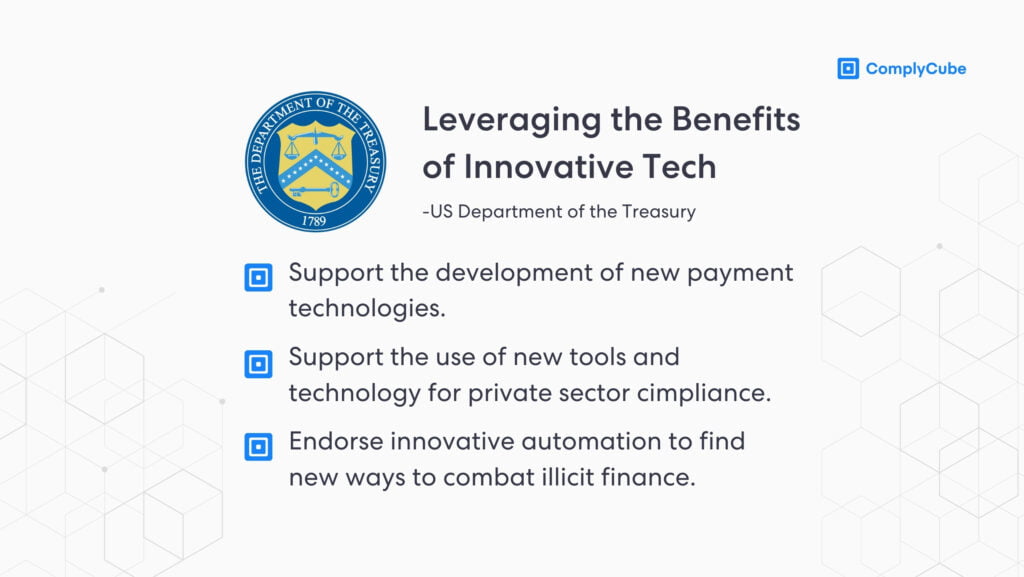
The UK has also seen limited progress. While there are laws against the creation and distribution of personal harmful deepfake content, such as explicit deepfakes, broader regulations addressing the creation and use of deepfakes for electoral manipulation are yet to be enacted.
For now, it remains up to the business in question to adopt robust IDV solutions to counter the deepfake fraudulent movement. Businesses must include the possibility of deepfake fraud in their Risk-Based Approach (RBA) when considering a suitable AML strategy.
About ComplyCube
To combat the growing threat of AI fraud, deepfake detection technology and IDV solutions are now essential. These technologies utilize Gen AI to scan similar data sets that are used to create deepfakes to identify fake content and mitigate fraud.
ComplyCube’s document verification and biometric verification are two key methods used in IDV to verify and authenticate identities by detecting deepfake content and are employed by hundreds of tech firms around the world.
The leading provider of IDV solutions was built to combat the growing threats of innovative fraudulent methodologies in the 21st century. By leveraging advanced AI and machine learning algorithms, ComplyCube’s platform offers comprehensive IDV and biometric verification services, ensuring robust protection against identity fraud and deepfake content.
Boasting a flexible and customizable solution, their services can be tailored according to a firm’s RBA to help businesses enhance their security protocols, maintain compliance with regulatory standards, and build trust with their customers in an increasingly digital world. For more information, reach out to a compliance specialist today.


